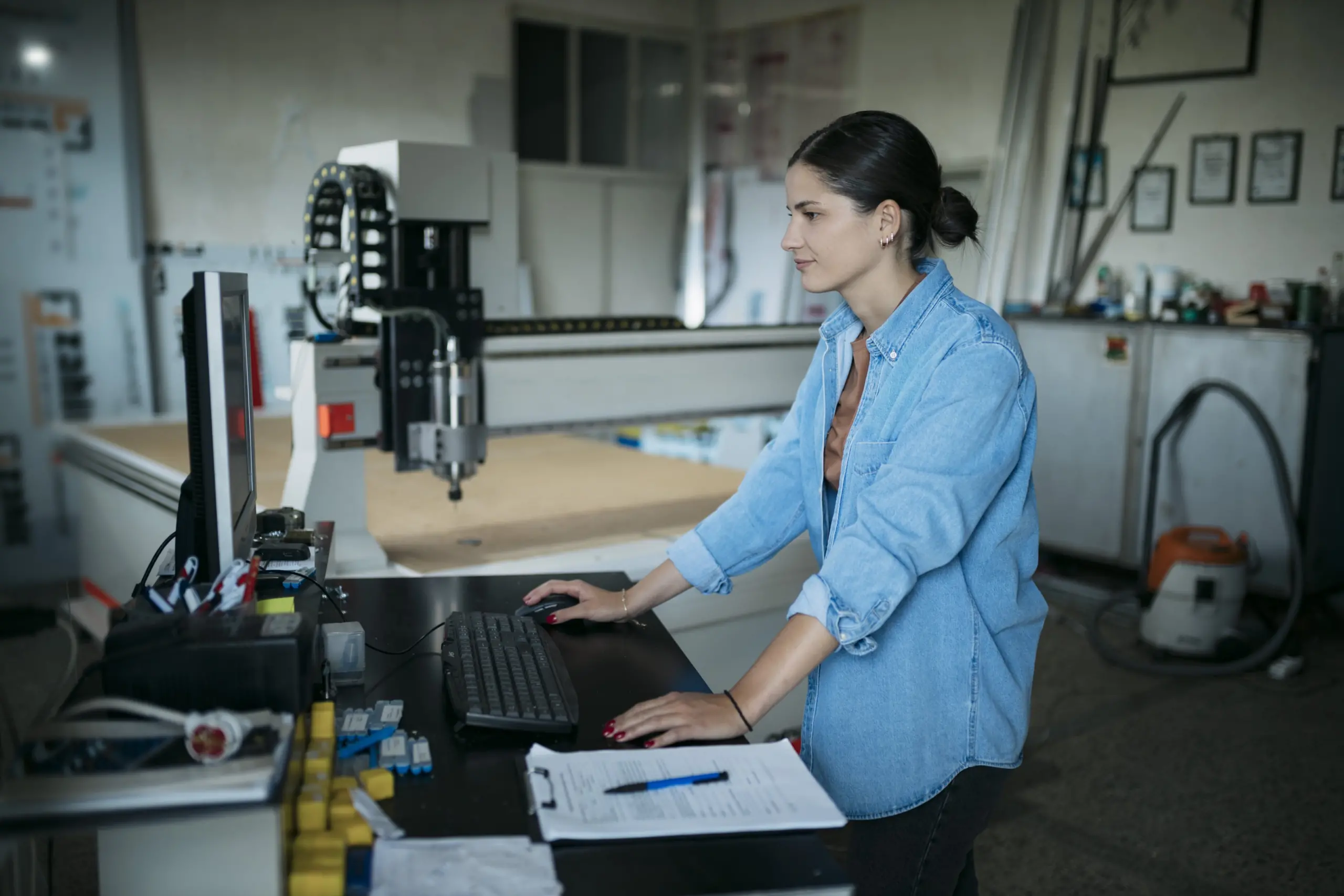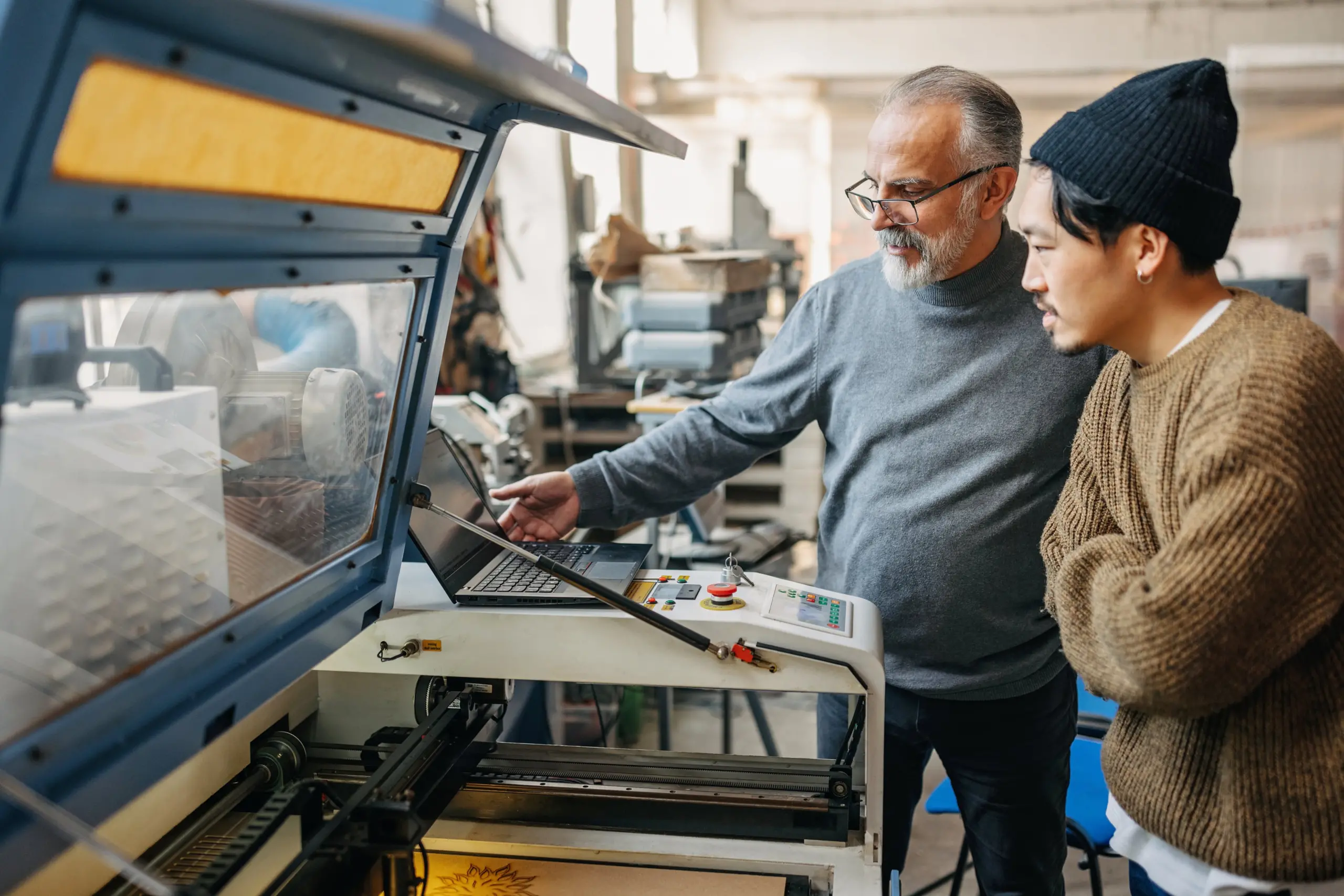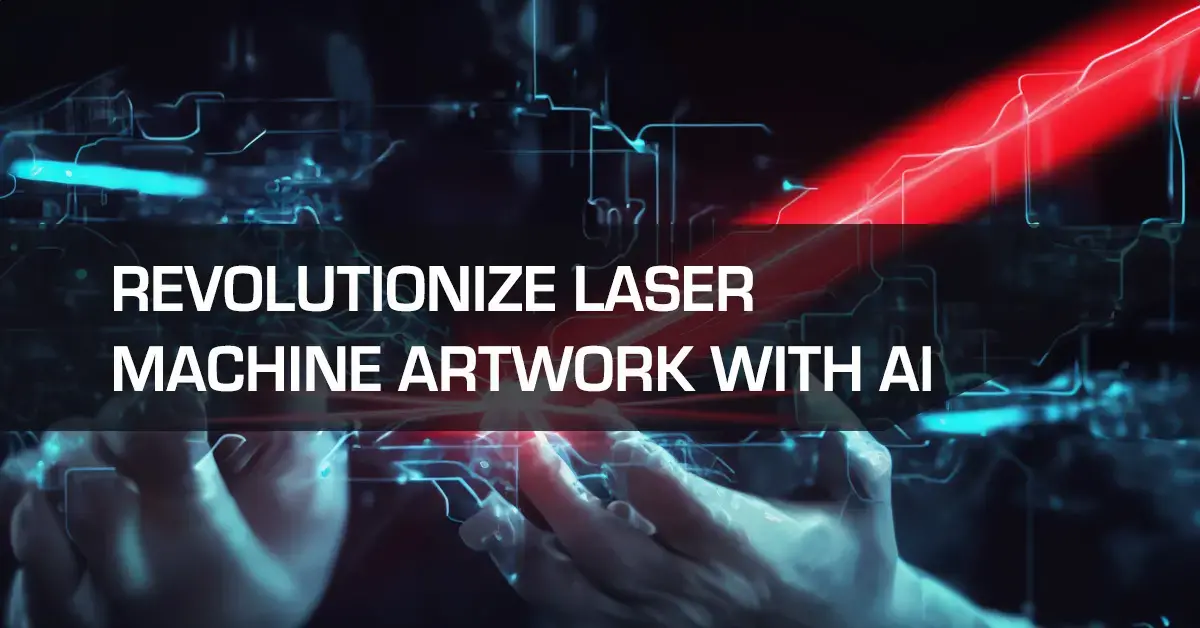Revolutionizing Laser Cutting Machine Artwork with AI
Picture this: a client sends over a file that they want laser engraved on the largest piece of wood your laser can handle. It is going to be a big project that will tie up your machine for almost an entire day. We all love these big jobs because the bigger the job, the higher the revenue. But when you go to open the file, your heart sinks. Your machine can handle 48” wide material, but the file you just opened is 2” x 2”. To make matters worse, it is a raster file.
You quoted this project at 6 hours. You have two options: A) go back to the client and tell them it cannot be done with this file, or B) eat the cost of labor it will take to convert that file to a vector image that can be scaled up to fit the project.
Almost everyone with a laser business has been in this scenario. Well, not anymore.
AI is everywhere in today’s world. You might even be wondering if it wrote this article. Artificial Intelligence is changing the world around us, and now it will change how we laser. The fusion of AI and laser machines has opened up a world of possibilities, enabling laser operators to effortlessly create vector artwork from simple text inputs and convert raster images into vectors. Let us explore how AI is reshaping the laser machine industry by facilitating the creation of intricate vector artwork, making it easier for laser operators to craft captivating visuals for their clients, and unlocking the potential of raster-to-vector conversion.

The Significance of Vector Artwork in Laser Cutting Machines
In laser cutting and engraving, vector artwork is an enduring symbol of precision and quality. Unlike its raster counterpart, which relies on pixel grids to define shapes and images, vector graphics are meticulously crafted using mathematical equations. This unique foundation grants vector art the remarkable ability to be scaled infinitely without even the slightest hint of quality loss. Each element in a vector graphic is defined by coordinates, lines, and curves, allowing for unparalleled precision in design. Any beginner laser operator can quickly learn the value of vector graphics.
Vector graphics, on the other hand, retain their crispness and sharpness regardless of scale, making them indispensable for tasks requiring pinpoint precision, intricate designs, and delivering results that consistently surpass clients’ expectations. The unrivaled versatility and fidelity of vector art ensure that every laser-cut project is a masterpiece of precision and craftsmanship, setting a high standard for excellence in the laser machine industry.
Streamlining Text-to-Vector Conversion
The integration of AI into laser machine operations represents a groundbreaking advancement, particularly in text-to-vector conversion. Traditionally, laser operators faced the daunting task of manually transmuting simple text inputs into vector artwork. This labor-intensive process involved hours of painstaking work, navigating the intricacies of font styles and details.
However, the advent of AI has brought about a paradigm shift. AI-driven text-to-vector generators have transformed this once time-consuming endeavor into a swift and seamless operation. Now, operators can effortlessly input text and witness the magic of AI algorithms at play as they rapidly dissect the input, identify the most suitable font styles, and translate them into highly scalable vector graphics.
The significance of this development cannot be overstated. Beyond the monumental time savings, AI ensures that custom text engravings consistently maintain an impeccable level of precision and aesthetic appeal. Each character, line, and curve is meticulously rendered to perfection, culminating in visually captivating results that meet and often exceed clients’ expectations. This newfound efficiency and precision are revolutionizing the laser machine industry, empowering operators to produce remarkable text-based designs with unparalleled ease and finesse.
Expanding Design Horizons
AI-powered vector generators are not confined to textual elements alone; they can generate vector artwork from rudimentary shapes and creative concepts. This opens the door to an expansive realm of design possibilities, limited only by the imagination of the laser operator. Complex patterns, logos, and intricate designs can be effortlessly brought to life through AI’s interpretative prowess.
This transformative feature has a profound impact, particularly for businesses specializing in intricate and customized laser cutting and engraving work. It liberates operators from the constraints of manual design processes, allowing them to explore a broader design repertoire. As a result, clients benefit from an extensive array of creative options, ensuring that each project is a unique masterpiece tailored to their exact specifications.
Raster-to-Vector Conversion
The conversion of raster artwork into vector art through AI is another remarkable dimension of AI’s impact on laser machine operations. Raster images, commonly encountered in photographs or scanned images, are inherently pixel-based and often prove unsuitable for laser cutting or engraving without prior vectorization.
AI algorithms, however, have transcended this limitation. These advanced algorithms are endowed with the capacity to meticulously analyze and decode the complex shapes and contours within raster images. With their unmatched computational prowess, AI seamlessly translates these pixel-based images into vector format. This transformative process not only rescues valuable time but also preserves the integrity of the original artwork. The results are nothing short of impressive – intricate details, impeccable precision, and faithful replication of the initial image’s quality, guaranteeing that the final laser-cut or engraved product is a true work of art. In essence, AI’s ability to convert raster artwork into vectors represents a substantial leap forward in efficiency and quality, demonstrating the technology’s invaluable contribution to the laser machine industry and design field as a whole.
How AI Simplifies Laser Machine Operations
Time Efficiency
Integrating AI-powered vector generation and raster-to-vector conversion significantly reduces the time dedicated to artwork preparation. This time-saving aspect is pivotal for meeting tight deadlines and efficiently handling a higher volume of projects.
Precision and Consistency
AI algorithms are meticulously designed to pinpoint and rectify any inconsistencies in vector artwork. This unwavering precision is fundamental for maintaining brand integrity and delivering unparalleled results to clients.
Creative Freedom
AI-equipped laser operators are now unburdened by the limitations imposed by manual vectorization processes. These AI-driven tools provide ample room for experimentation and the exploration of diverse design ideas, enabling operators to offer clients a broader spectrum of choices.
AI-Powered Laser Engraving Machines: Case Study
Traditional Approach
In the traditional approach, as a laser operator, you face a time-consuming and meticulous process. First, you’d have to select a script font that aligns with your client’s vision. This might involve browsing through various font libraries or creating a custom font. Once the font is chosen, you manually vectorize the script font, which requires precision and attention to detail to ensure the final output is elegant and readable. Next, you’d turn your attention to the lace pattern, which would either involve sourcing a pre-existing design or creating a new one from scratch. This step also involves vectorization, ensuring the design is suitable for laser cutting. The overall process could take several hours or even days, depending on the complexity of the design and your proficiency with design software.
AI-Powered Approach
On the other hand, the AI-powered approach streamlines this process significantly. After receiving the client’s names, you input them into an AI-powered vector generator, specifying the desired elegant, flowing script style. The AI software swiftly converts the text into a beautiful, laser-ready vector design using advanced algorithms and a vast database of font styles.For the lace pattern, you provide a description of what you’re envisioning – perhaps specifying details like floral elements, the level of intricacy, or the general style. The AI then processes this description and generates a detailed lace pattern in vector format tailored to your specifications. This process is remarkably faster, potentially reducing what would have taken hours to just a few minutes. It ensures consistency in design quality and allows for easy adjustments or iterations based on client feedback.
Real Data Support
According to a study by McKinsey, AI has the capability to automate up to 45% of repetitive work, allowing workers to focus on more creative and strategic tasks. In graphic design, AI tools have been shown to reduce design time significantly. For example, Adobe’s Sensei AI helps designers with tasks like image editing and pattern generation, which can speed up the workflow by about 30% compared to traditional methods. In the specific case of vectorization, AI tools like Vector Magic have demonstrated the ability to rapidly convert images to vector designs, a task that would otherwise be time-consuming when done manually. This shows that the integration of AI in design work, such as creating custom wedding invitations, can substantially reduce effort and time, corroborating the benefits outlined in the AI-powered approach.
Choosing the Right AI Tool for Your Laser Cutting Machine
To harness the full potential of AI in your laser machine operations, it’s essential to choose the right AI tool. Here are some factors to consider:
- User-Friendly Interface: Look for AI tools with intuitive interfaces that make it easy for operators without extensive design backgrounds to use them effectively.
- Compatibility: Ensure that the AI tool you select is compatible with your specific laser machine model and software. Compatibility issues can hinder seamless integration.
- Customization: Seek AI tools that offer customization options, allowing you to fine-tune the generated vector artwork to align with your client’s preferences.
- Customer Support: Opt for AI tool providers that offer robust customer support and regular updates to ensure the tool remains reliable and up-to-date.
- Cost and Licensing: Evaluate the cost and licensing structure of the AI tool to ensure it aligns with your budget and usage requirements.

The Future of Laser Machines and AI
As technology advances, the connection between laser machines and AI will only grow stronger. Here are some emerging trends and possibilities:
Real-time Design Enhancement
Integrating AI algorithms directly into laser machines offers the promise of real-time design improvement. During the cutting and engraving process, AI can continuously analyze and optimize the design, correct errors, and enhance details on the fly. This real-time feedback loop ensures that the final product is of the highest quality.
AI-Driven Material Selection
AI can assist operators in selecting the most appropriate materials for specific projects based on design requirements and desired outcomes. By analyzing the project’s needs and available materials, AI can optimize efficiency, reduce waste, and ensure that the chosen material aligns perfectly with the design goals.
Enhanced Design Libraries
AI-powered design libraries are poised to become more extensive and sophisticated. These libraries will provide laser machine operators with a broader selection of pre-designed elements, patterns, and templates to incorporate into their projects. This resource will streamline the design process and enable operators to experiment with a rich array of creative options.
The fusion of Artificial Intelligence and laser machines has ushered in a new era of laser cutting and engraving, where precision, intricacy, and efficiency reign supreme. Vector artwork, with its mathematical foundation and infinite scalability, forms the bedrock of excellence in laser machine operations. AI has emerged as a powerful ally, simplifying intricate processes and expanding creative horizons. AI’s transformative capabilities in text-to-vector conversion have revolutionized the way laser operators work, eliminating the arduous manual tasks of font selection and vectorization. This saves valuable time and ensures consistently precise and visually captivating custom text engravings.
Furthermore, AI has unlocked new design possibilities by enabling vector generation from basic shapes and concepts. This empowers laser operators to effortlessly craft complex patterns, logos, and designs, offering clients a wider array of creative options. AI’s prowess in raster-to-vector conversion is equally remarkable. By deciphering the shapes and contours within raster images, AI preserves the quality and intricacy of the original artwork, ensuring that laser-cut or engraved projects consistently impress clients.
The integration of AI and laser machines is transforming the industry, making it easier for laser operators to produce intricate and visually stunning projects. AI’s ability to create vector artwork from text inputs and convert raster images into vectors represents a monumental leap forward, ensuring that the laser machine industry continues to captivate and inspire with its precise, intricate, and visually captivating creations.
AI just saved your 6 hour project, and it won’t be the last time.
Contact Us
With a commitment to safety and excellence, Boss Laser empowers professionals and entrepreneurs to achieve their goals with cutting-edge laser technology. By following these best practices, you can rest easy using your laser machine knowing you, your team, and your workspace are safe. Contact Boss Laser today to learn more about the safety features of your machine or to purchase new laser equipment.
